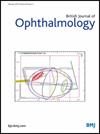Meibum and lid margin microbiome in eyes with chalazion: exploring an infectious aetiology
IF 3.5
2区 医学
Q1 OPHTHALMOLOGY
引用次数: 0
Abstract
Purpose The current study evaluated the meibum and lid margin microbiome of eyelids with chalazion and compared it with contralateral uninvolved eyelids and healthy controls. Methods Chalazion contents (group 1) and expressed meibum swabs from the lid margins of seven patients with chalazion (mean age 29±12 years; >6 weeks chalazia duration) and age-matched healthy controls were sequenced using next-generation 16S rDNA V3-V4 variable region sequencing. The meibum from the contralateral eye of patient with chalazion served as sample control (group 2), and healthy individuals served as negative control (group 3). The contents were also plated using conventional culture techniques. Results Meibomian glands expressed thick turbid meibum in the area of chalazion in five out of seven eyelids. Contralateral uninvolved eyelids and healthy control glands were expressible with clear meibum. The mean Schirmer I value was 24.6±4.9 mm. Lid margin and meibum microbiome profiling revealed significant differences between the patients (involved or uninvolved sides) and healthy controls. The predominant phyla were Proteobacteria, Bacteroidota and Actinobacteria in all three groups. Acinetobacter , Moraxella and Paracoccus were the predominant genera in groups 1 and 2. Significant differences were noted in the predominant genera between group 3 versus groups 1 and 2. Principal coordinate analysis revealed overlap between groups 1 and 2, whereas group 3 had a distinct cluster. None of the culture media (for aerobic, anaerobic bacteria and fungus) showed any bacterial growth. Conclusion In patients with unilateral chalazion, involved and uninvolved eyelids share similar lid margin and meibum microbiome but differ from the healthy controls. Data are available upon reasonable request.眼睑和眼睑边缘微生物组在眼睛失明的感染病原学探讨
目的 本研究评估了霰粒肿患者眼睑的睑板腺和睑缘微生物群,并将其与对侧未受影响的眼睑和健康对照组进行了比较。方法 采用新一代 16S rDNA V3-V4 可变区测序法对 7 名霰粒肿患者(平均年龄为 29±12 岁,霰粒肿病程大于 6 周)和年龄匹配的健康对照组的霰粒肿内容物(第 1 组)和睑缘分泌的咽蜜拭子进行测序。霰粒肿患者对侧眼的睑板腺作为样本对照(第 2 组),健康人作为阴性对照(第 3 组)。此外,还采用传统培养技术对睑板腺内容物进行培养。结果 7 个眼睑中有 5 个的睑板腺在霰粒肿部位分泌浓稠混浊的睑板腺液。未受影响的对侧眼睑和健康对照组的睑板腺则分泌清澈的睑板液。平均施尔默 I 值为 24.6±4.9 毫米。睑缘和睑板腺微生物组图谱显示,患者(受累或未受累侧)与健康对照组之间存在显著差异。在所有三组中,最主要的菌群是变形菌、类杆菌和放线菌。第 1 组和第 2 组的主要菌属是醋杆菌、莫拉菌和副球菌。第 3 组与第 1 组和第 2 组的优势菌属有显著差异。主坐标分析表明,第 1 组和第 2 组之间存在重叠,而第 3 组则有一个明显的群集。所有培养基(需氧菌、厌氧菌和真菌)均未发现细菌生长。结论 在单侧霰粒肿患者中,受累眼睑和未受累眼睑的睑缘和睑板微生物群相似,但与健康对照组不同。如有合理要求,可提供相关数据。
本文章由计算机程序翻译,如有差异,请以英文原文为准。
求助全文
约1分钟内获得全文
求助全文
来源期刊
CiteScore
10.30
自引率
2.40%
发文量
213
审稿时长
3-6 weeks
期刊介绍:
The British Journal of Ophthalmology (BJO) is an international peer-reviewed journal for ophthalmologists and visual science specialists. BJO publishes clinical investigations, clinical observations, and clinically relevant laboratory investigations related to ophthalmology. It also provides major reviews and also publishes manuscripts covering regional issues in a global context.

 求助内容:
求助内容: 应助结果提醒方式:
应助结果提醒方式:


